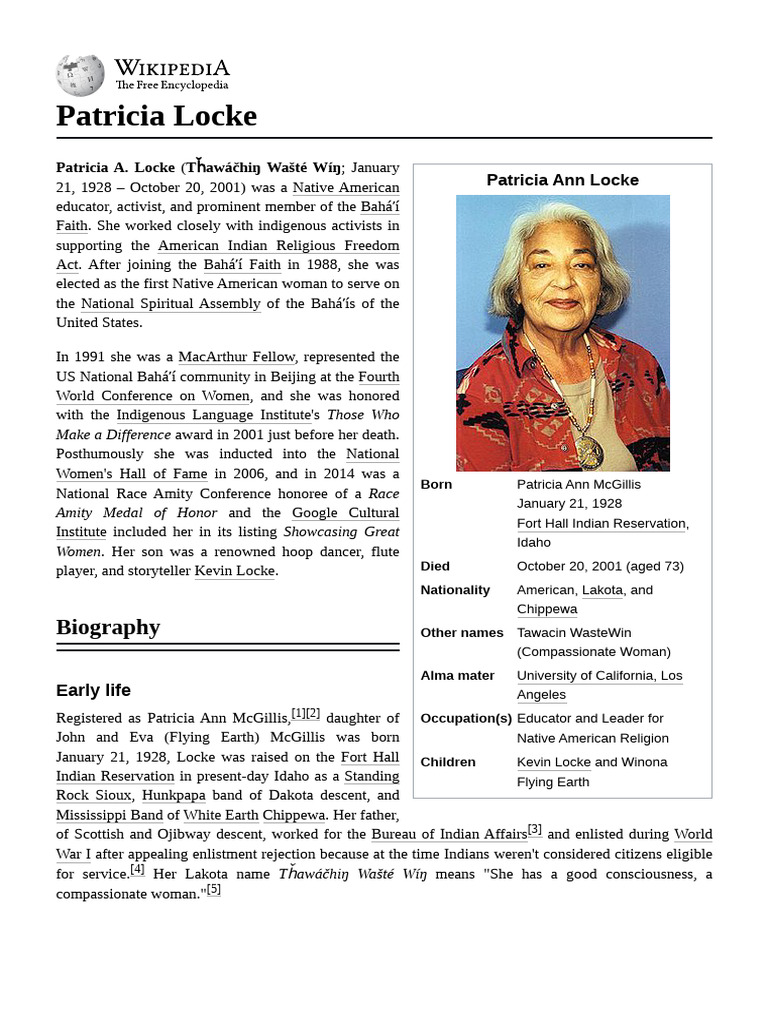The Bahá’í Faith, a relatively nascent religion characterized by its radical commitment to unity and the oneness of humanity, captures a unique perspective on the interplay between faith and identity. One illuminating narrative within this tapestry is the story of Patricia Locke, an Indigenous leader whose embrace of the Bahá’í Faith not only transformed her spiritual journey but also highlighted the religion’s resonance with Indigenous peoples. Understanding this intersection of beliefs provides fertile ground for exploring the wider implications of Bahá’í teachings within Indigenous contexts.
Patricia Locke, known for her potent advocacy for Indigenous rights and social justice, provides an archetype of how the Bahá’í Faith can merge with, and enrich, Indigenous beliefs. The teachings of the Bahá’í Faith promulgate the idea of radical inclusivity, mirroring Indigenous worldviews that prioritize harmony with the natural world and collective well-being. This synthesis of belief systems underlines a shared vision for a just and equitable society, which resonates strongly within the narrative of Locke’s spiritual transition.
At its core, the Bahá’í Faith champions the principle of the oneness of humanity. This tenet advocates for the dismantling of racial, ethnic, and cultural barriers, positioning the human experience as an interconnected whole. For Indigenous peoples, who have historically encountered marginalization, this principle reverberates powerfully. Locke’s embrace of Bahá’í teachings reflects a commitment to social justice, advocating for rights that transcend individual tribal affiliations and embrace a universal kinship.
Locke’s journey into the Bahá’í community also highlights the religion’s emphasis on equality, particularly gender equality. The Bahá’í teachings assert that gender is not a divisive force but rather a complementary aspect of human existence. This egalitarian ethos resonates with Indigenous cultural values, where many tribes honor women’s roles as central to societal structure. By merging these perspectives, Locke not only reinforced her advocacy for women’s rights but also inspired a broader discourse on gender relations within Indigenous communities.
The Bahá’í Faith posits that every religion possesses a truth that contributes to the overarching narrative of a unified humanity. This foundational belief enables a dialogue between disparate faiths, facilitating understanding and mutual respect. Patricia Locke’s journey underscores this dynamism, illustrating how Indigenous spirituality can harmonize with Bahá’í principles, creating a dialogue that honors both her heritage and her faith. The act of finding common ground becomes not merely an academic exercise but a profound act of spiritual reaffirmation.
The communal aspect of the Bahá’í teachings encapsulates the importance of community engagement and collective action. Locke’s participation in the Bahá’í community serves as a model for how communal efforts can unify people in purpose, particularly around social action initiatives aimed at uplifting marginalized communities. Her experiences reveal that the Bahá’í pursuit of service aligns seamlessly with Indigenous traditions of collective responsibility and mutual aid. This duality enriches both narratives, fostering a spirit of cooperation and shared purpose.
Locke’s embrace of the Bahá’í Faith also unfolds the critical narrative of the reconciliation process between Indigenous identities and mainstream religions. In many ways, her journey signifies a reclamation of agency, allowing her to navigate and integrate various elements of her identity—the sacrosanct nature of her Indigenous heritage intertwines with Bahá’í teachings. This reconciliation invites others within Indigenous circles to consider how broadening spiritual horizons can lead to empowerment and self-affirmation.
The Bahá’í Faith emphasizes education as a cornerstone of societal transformation. This belief is profoundly echoed in Locke’s advocacy for the educational empowerment of Indigenous youth. By engaging with Bahá’í principles, she could leverage the faith’s global reach and appeal to promote education initiatives that honor Indigenous knowledge systems while retaining a global perspective. The dual emphasis on spiritual and intellectual development within the Bahá’í teachings dovetails with Indigenous philosophies, advocating for a holistic approach to education that enriches individual and collective identities.
Moreover, the Bahá’í emphasis on justice as a divine principle resonates deeply within the Indigenous experience. Locke’s narrative reveals her profound commitment to justice, drawing parallels between Bahá’í teachings and Indigenous struggles for recognition and rights. Justice, in the Bahá’í context, is not merely about legal frameworks but encompasses a broader ethical imperative to ensure fairness and equity. This alignment serves to inspire a deeper commitment to justice-oriented action within both Indigenous and Bahá’í communities.
Finally, Patricia Locke’s embrace of the Bahá’í Faith underscores a vital narrative of faith as a transformative journey. This evolution is not merely a transition into a new belief system; it symbolizes an integration of values that champion inclusivity, equity, and justice. Her commitment to progressive ideals within the Bahá’í framework demonstrates the religion’s adaptability and its potential to resonate with diverse cultural perspectives. This synergy between Locke’s Indigenous identity and her Bahá’í beliefs amalgamates into a vibrant narrative that transcends simple categorization, enabling a richer understanding of both the challenges and opportunities present at this spiritual crossroads.
In summary, the unique narrative of Patricia Locke exploring the Bahá’í Faith unveils diverse lessons encompassing social equity, justice, community engagement, and the importance of education as a tool for empowerment. Through her story, readers gain insights into the transformative power of faith and the possibilities inherent in the convergence of belief systems, particularly for those seeking to harmonize their identities within a multicultural landscape. Ultimately, Locke’s journey exemplifies the continuous quest for understanding, connection, and a well-lived life in service to humanity and the environment.
